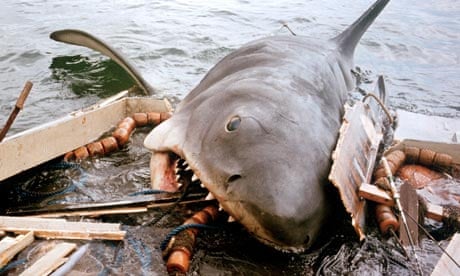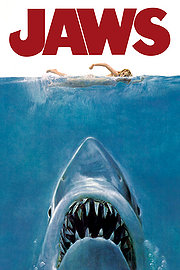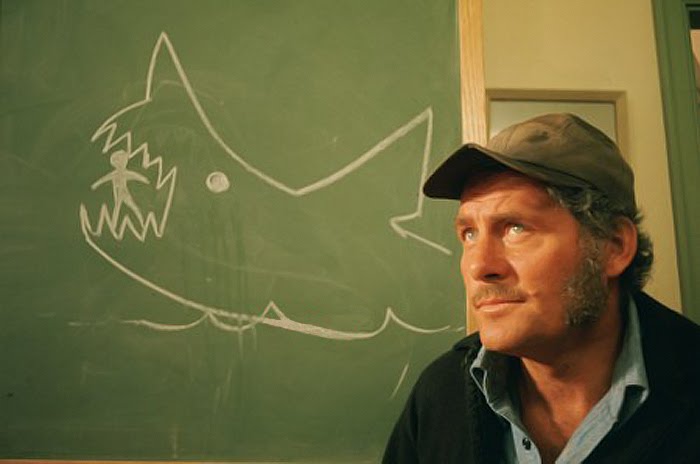Jaws, Spielberg’s second major film[1] , released in 1975 is widely recognised as an important piece of cinema, with one of the most memorable and suspense building soundtracks of all time. Despite the creepy and more blood thirsty elements of the film there are also moments of humour, as comedy plays quite a large role in briefly allaying the audiences’ fears.
The film is interesting as in making it Spielberg set himself many challenges, for instance: filming in the Atlantic Ocean rather than a controlled pool, adapting a novel for a screenplay and perhaps most importantly raising the question as to how exactly do you film a man-made shark, making it believable and terrifying at the same time? Thus the problematic nature of filming and production sets the scene for an excellent film, with humour, suspense, memorable lines and moral problems all ensuring it has endured the test of time.
When a skinny dipping reveller disappears after a moonlit swim, police are informed and a search is carried out. Upon finding the remains of the body, it is deemed that the cause of death was a shark attack. Unfortunately, the mayor of the town does not want this information to be made public as he is worried about the impact it will have on tourism, and Amity’s reputation as a beach resort. As such, the mayor demands that it be kept a secret, and the death be blamed on drowning. Police Chief Brody is not satisfied with the Mayor’s reasoning and is troubled by the prospect of a killer shark on the loose. A young boy is killed by the shark, and his mother places a bounty on the shark’s head, prompting local men to go out and hunt it. They catch a shark, but, unbeknown to them it is not the murderous beast they had been looking for.
Brody enlists the help of experienced shark hunter Quint and marine biologist Hooper to find the culpable shark once and for all. Once on their search for the murderous shark they find it appears to have its own agenda as it causes their boat to flood and puts all three men on board in peril. Quint comes to a messy end as he is eaten alive by the shark but Brody manages to outwit it by rolling an oxygen tank into the shark’s mouth, and then shoots at it with a rifle causing it, and the shark, to explode.
The shark is hugely important in Jaws as a sense of fear is created around it despite it actually featuring quite infrequently throughout the film. Spielberg employs the use of sound and visual representations of the aftermath of the shark in order to make us fearful of it, a technique that is reminiscent of Hitchcock, where fear is created through the audience’s imagination. When we finally see the shark towards the end part of the film it becomes less frightening as it is recognisable as a tangible villain. Given the age of the film, and the difficulty in manufacturing a life-like shark, it becomes less believable as we see it as a gross exaggeration and fictionalization that perhaps wasn’t as terrifying as our imaginations had conjured up. The shark is more than an element of fear in the film however, as it serves to highlight moral problems within the Amity community. The mayor’s greed far outweighs his concern for citizens of the town and holiday makers as he is determined the beaches remain open for the 4th of July celebrations, endangering thousands of people. This disregard for the safety of the public in the face of potential financial gain is something that most certainly does not encourage us to form an alliance with the mayor, and leads us to further support Brody on his mission to close the beaches and protect the public. It also serves to make us more affected by the deaths within the film, as it is likely that more people will be killed by a bloodthirsty shark when there are few safety measures in place.
Despite the title of the film, and being the main feature of the promotional posters, the actual shark itself doesn’t make many appearances during the 130 minutes running time. Apart from being a good way of creating fear around the unknown, not featuring the shark is also a useful way to avoid technical difficulties in building mechanical sharks and to avoid further costs. With regard to creating fear, Spielberg successfully makes the audience wary of the unseen creature through the suggestion of its presence, for example showing a tip of the fin breaking through the water’s surface and showing the effect of its movements above water on its victims. This, along with the pools of blood left in its wake cause the audience to speculate on its size and its ferocity, manifesting a feeling of fear, without having to show that which the cause of it is. The sequence of two notes played whenever the shark is on screen or is soon to close in on its prey signal an impending sense of doom and put the audience on its guard as they anticipate something unpleasant is about to happen. This association with the music is clear from the outset and as such instantly builds to connection for the viewer- when you hear these sounds, be fearful. Apart from the music, the cinematography is also hugely important in building tension in the film. The dolly zoom is used to great effect to capture Brody’s increasing sense of panic and nervousness while sat on the beach having what should be a relaxing shoulder massage from his wife. He remains in the centre of the shot while the background appears to increase in size behind him, changing the depth of perception and making the viewer share his sense of unease and inability to look away from the sea.[2]
The human characters in the film treat the shark with suitable vehemence after it begins attacking Amity’s shores and from the outset see it as a monster to be challenged rather than an animal to be studied or treated with any respect. Like the audience, the characters in the film often do not actually see the shark – until it is too late that is – despite their best efforts to catch a glimpse of it. At times the human characters in the film are presented as having a humorous relationship with the shark, a particularly good example of a (potential) human – animal encounter is the scene in which Brody silently acts as a lookout on the beach and is continually led to believe that he might be witnessing shark attacks which are in fact people screaming and playing in the sea. This comedic scene briefly relieves the tension on screen within the film itself as well as giving the audience some brief moments of respite. The relief humour theory states that ‘people experience humor and laugh because they sense stress has been reduced in a certain way (Berlyne, 1972; Morreall, 1983; Shurcliff, 1968)[3]
As such, after tension has been built by hearing screams and seeing thrashing movements in the water, when the audience realises it is nothing sinister, the product of laughter is a manifestation of the release of that tension. During Jaws comedy infiltrates the mood of suspense throughout the film, causing the
audience to briefly lower its guard.
Of all the characters in the film it is Quint who is most viciously set on finding and killing the shark, turning its role as predator into that of prey. It is perhaps ironic in fact that out of the three men (Quint, Brody and Hooper) that the one who is the seasoned shark hunter and is most desperate to bring about its death is the only one that dies at the – fins – of the shark. Conversely, the character in the film with the most authority and the one who should be acting in the public’s interest- the mayor, is least concerned with pursuing the shark.
The shark in the film is completely void of empathy from the other characters and as such as an audience we are not encouraged to sympathise with it either. It is interesting that sharks are frequently considered as morally ‘bad’ creatures in film whereas other predatory animals such as lions, tigers and bears are often presented as being morally ‘good’ and we are encouraged to empathize with them. This is the case with Rajah the tiger in Aladdin, Simba in Lion King and Baloo in the Jungle Book. Although those animals are innately wild (although perhaps arguably to different degrees), they are not seen as dangerous or as a threat. Due to their lack of ability to be cuddled or considered as conventionally ‘cute’, it seems that sharks are doomed to be untrustworthy as in (Finding Nemo), murderous (Thunderball) and bloodthirsty (Jaws). This villain of the animal kingdom fits its typecast perfectly in Jaws and firmly cements the shark as one of the most fearsome animals to be contended with in cinematic history.
References
[1]Tim Dirks, ‘Jaws (1975)’, Filmsite.org, 2015 <https://www.filmsite.org/jaws.html> [accessed 15/01/2015]
[2]Ian Freer, ‘Jaws Filmmaking 101 | Features | Empire’, empireonline.com, 2015 <https://www.empireonline.com/features/jaws-filmmaking-101/p2> [accessed 15/01/2015]
[3]John C. Meyer, ‘Humor As A Double-Edged Sword: Four Functions Of Humor In Communication’, Communication Theory, 10 (2000), 310-331 <https://onlinelibrary.wiley.com/doi/10.1111/j.1468-2885.2000.tb00194.x/pdf> [accessed 20/12/14]


